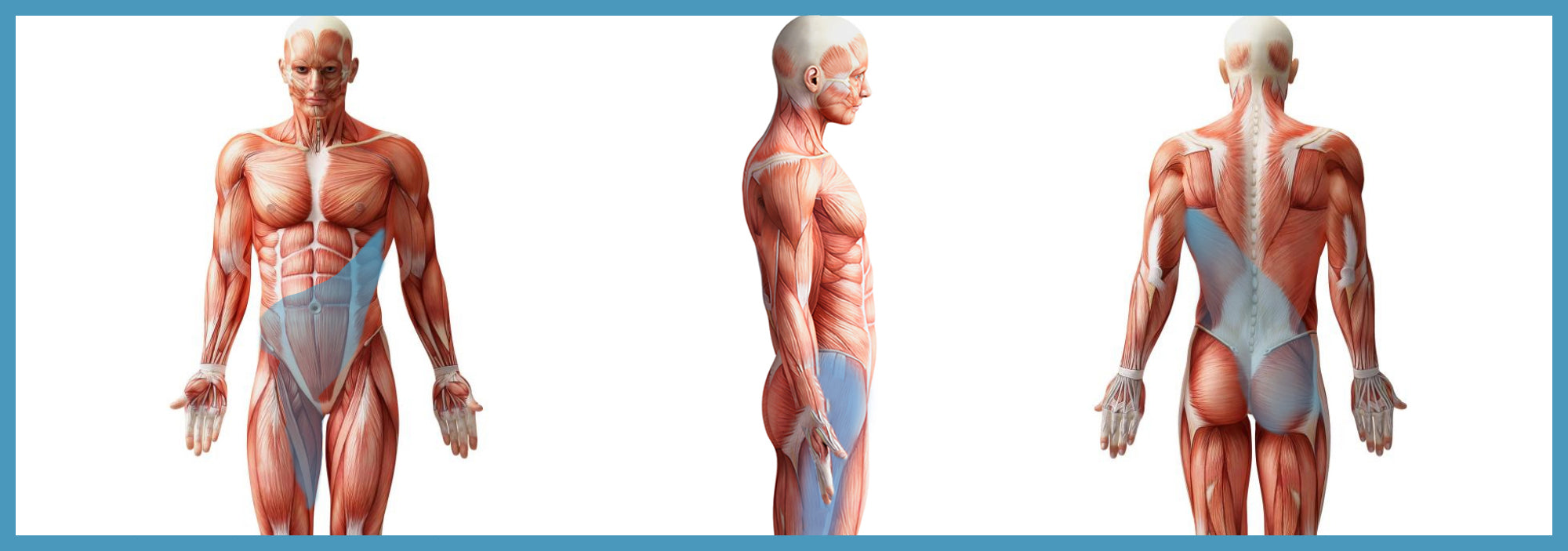
May 05 , 2021
0 Comments
Biomechanics Monthly | Muscular Systems and Anatomical Slings
Muscular Systems and Anatomical Slings
What is an Anatomical Sling?
An anatomical, or myofascial, sling refers to a given group of muscles, fascia, and ligaments functioning together to create stability and mobility. When we refer to a given movement we often think of certain muscles contracting in isolation in order to create a force within the area of that muscle, however in reality, muscles act in unison, or synergy, with other tissues in order to maintain alignment and create an efficient, predictable movement. Moreover, when a given muscle contracts, a force vector is created throughout the body causing additional muscular activity far from the initial contraction. Furthermore, these sling systems can be functionally connected, physically overlapping, or distantly related.
What are the Body’s Sling Systems
There are four major sling systems within the body, each with a unique purpose and composition of tissues.
Anterior Oblique Sling
The anterior oblique sling (AOS) consists of the ipsilateral (same side) external oblique connected to the contralateral (opposite side) internal oblique and adductors via the adductor-abdominal fascia. This sling system acts to both stabilize through opposing forces causing force (compression) closure at the symphysis pubis, while also creating a small amount of relative pelvic movement to assist with achieving heel-strike during gait. In addition, as movement becomes more advanced, as in running, the demands of the AOS become more prominent.
Posterior Oblique Sling
The posterior oblique sling (POS) developed as humans evolved into bipedal, or two-legged, creatures, thus increasing the stress and demand on the structures on the back side of the body. The major components of the POS include the ipsilateral (same side) gluteus maximus, and the contralateral (opposite side) latissimus dorsi. These two large muscles are functionally connected by the thoracolumbar fascia, and play a major part in dynamic lumbopelvic stability during functional movement. This system is most active during the stance phase of gait beginning just before heel strike, when a force vector is created at the ipsilateral hamstrings spreading up through the gluteus maximus to control, and offset, the opposing quadriceps contraction. As the body moves in to double limb support and transitions in to swing on the contralateral side the latissimus dorsi is contracted to eccentrically control the forward movement of the limb as well as maintaining stability as the trunk counter rotates. In addition, the POS is thought to have spring-like qualities assisting with conservation of energy during movement.
Lateral Sling
The lateral sling consists of the gluteus medius, gluteus minimus, tensor fascia latae, and iliotibial (IT) band. This system of interconnected tissues is most active in frontal plane stability. Functionally, this is best exemplified during single limb support activities such as walking, stairs, and higher level activities such as lunging and, single leg squatting, and landing mechanics during plyometrics. During these activities the lateral sling will come into tension in order to prevent hip drop while one limb is suspended and the other is in contact with the ground. The typical compensation for a weak or dysfunctional lateral sling is known as a Trendelenburg sign wherein the hip on the suspended side will drop, and the trunk will laterally flex toward the stance side in order to compensate for the lack of ability of the lateral sling to offset the force of gravity.
Longitudinal Sling
The longitudinal sling consists of ipsilateral erector spinae, multifidus, thoracolumbar fascia, sacrotuberous ligament, and biceps femoris. The longitudinal sling system is responsible for creating ipsilateral lumbopelvic stability while also allowing for movement in the sagittal plane. This is achieved by creating nutation at the sacroiliac joint. Additionally, the longitudinal sling system is primarily responsible for preventing sheer forces at the lumbopelvic region, thus will increase tension and activity during more demanding spinal flexion/extension activities such as deadlifting.
Myofascial Slings and Their Impact on Pain
As stated above, force vectors created by internal or external sources begin the chain of reactions and tissue interactions needed in order to produce functional movement. That being said, these force vectors create innate instability within the body and therefore the primary purpose of myofascial slings, in a global systems approach, is to offset these vectors and create stability. In addition, myofascial slings connect the upper and lower body segments to each other, generally intersecting at the lumbopelvic hip complex, transferring energy and force through the sacroiliac joint and lumbar spine. Therefore, given a dysfunctional sling system, whether related to a physical trauma, microtrauma, or weakened muscles, lower back pain can present, and recur due to inefficiencies and asymmetries in the transfer of force.
References
- Anatomy Slings and Their Relationship to Low Back Pain - Physiopedia. (n.d.). Retrieved December 26, 2020, from https://www.physio-pedia.com/Anatomy_Slings_and_Their_Relationship_to_Low_Back_Pain
- Basmajian, JV. Muscles Alive: Their Functions Revealed by Electromyography, Second Edition. Baltimore,: Williams & Wilkins, 1967.
- Lee, J.-K., Hwang, J.-H., Kim, C.-M., Lee, J. K., & Park, J.-W. (n.d.). Influence of muscle activation of posterior oblique sling from changes in activation of gluteus maximus from exercise of prone hip extension of normal adult male and female.




